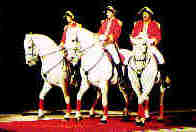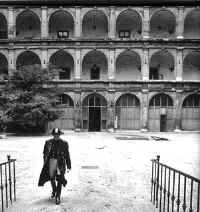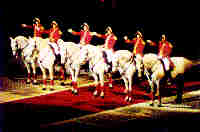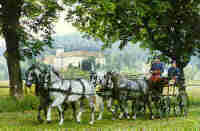
The Spanish Riding School
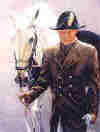 The great double doors at the end of the riding hall swing slowly, slowly open, moved by invisible hands. The violins of Bizet's "Arlésienne Suite" breathe a gentle invitation,
and from the gloom of the passageway the first horse and rider, an apparition in brown and white, move gravely forward into the hushed arena.
The great double doors at the end of the riding hall swing slowly, slowly open, moved by invisible hands. The violins of Bizet's "Arlésienne Suite" breathe a gentle invitation,
and from the gloom of the passageway the first horse and rider, an apparition in brown and white, move gravely forward into the hushed arena.
Seven other riders in file follow the leader. Soberly uniformed in the cinnamon livery of a bygone era, they exhibit the same impassive, taut control of themselves and their mounts. Beneath the many-faceted chandeliers - Christmas trees of dripping ice - they parade the length of the gold-and-ivory hall until, approaching the lofty portrait of Charles VI, they doff their two-cornered hats in wide-sweeping salute.
A trip to the Spanish Riding School
Die Spanische Hofreitschule zu Wien
(Foto right up: Stallions Vienna Hofburg)
Lipizzaner: Originally andalusian horse, trained in Lipizza / Slovenia for military purpose, now located in Piber / Styria-Austria (Foto left) |

back to Culture & History


Created 1994 by © LabelArt WebDesign - Austria

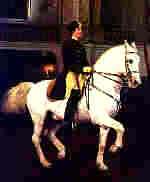
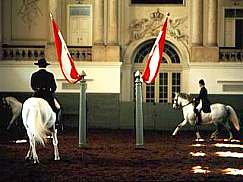

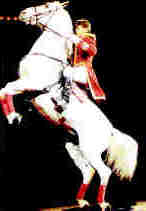 The deliberate, majestic gesture wrings a spurt of applause from the audience packing the double balconies. For the spectators instinctively recognize in this homage more than a formal tribute to an imperial patron of the Spanish Riding School. They sense here a willing acknowledgment by today's riders that they are the trustees of a fragile but precious tradition of horsemanship that has been passed along, by word and example, from one generation to another through the centuries.
The deliberate, majestic gesture wrings a spurt of applause from the audience packing the double balconies. For the spectators instinctively recognize in this homage more than a formal tribute to an imperial patron of the Spanish Riding School. They sense here a willing acknowledgment by today's riders that they are the trustees of a fragile but precious tradition of horsemanship that has been passed along, by word and example, from one generation to another through the centuries.